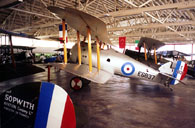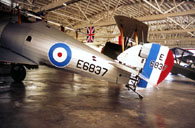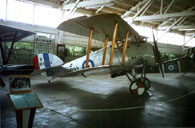Blue Max 1/48 Sopwith Snipe
By Jim Schubert
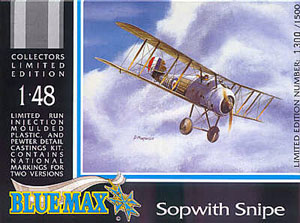 |
History
Very simply, the Snipe was the Camel's successor. Its design was intended to maximize the Camel's virtues and minimize the Camel's vices. To this end the pilot sat higher in the fuselage and could easily see over the upper mainplane, which was set much closer to the fuselage. Horsepower for the Snipe was bumped from the Camel's 110, 130 or 150 to 230 with the Bentley B.R.2 rotary engine. Entering service in the summer of 1918 the Snipe was acknowledged by all who flew it to be substantially better than the Camel. The Snipe soldiered on with the RAF through the lean budget post WWI years until finally superseded by the Gloster Gamecock in 1926. Although eight years was a long service life for a fighter back then, it is nothing these days; the Tomcat has been flying for 30 years.
This review of the limited edition Blue Max kit is the result of an exciting undertaking by IPMS-Seattle and the North West Scale Modelers to build a 1/48th scale model of each of the 24 planes purchased by our Seattle Museum Of Flight (MOF) from the Champlin Fighter Museum at Falcon Field in Mesa, Arizona. The models will be displayed as surrogates for the real articles for the several years until the MOF's new West Wing is ready to receive the Champlin collection. We will be building the models to accurately represent the Champlin planes - mistakes and all. Thus my Snipe will be slightly mispainted and "powered" by a 220 HP Continental R-670, seven cylinder, radial from Engines and Things rather than by a 230 HP Bentley B.R.2, nine cylinder, rotary. The Champlin Snipe is a replica built in 1982 and marked (mostly) as the plane flown by Air Marshall the Earl of Bandon ("The Abandoned Earl") when he was a young Flying Officer at the No. 5 Flying Training School at Sealand in 1921. This specific plane is mentioned on page 30 of Reference A, is pictured on page 43 of Reference D and is profiled on page 11 of Reference C. The models are to be displayed for the first time, as a group, at the NWSM's February 2002 Model Display in the MOF's East Gallery.
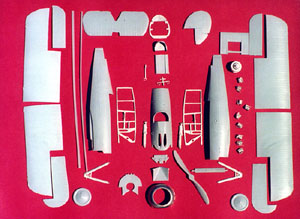 The Kit
The Kit
Eduard, oh Eduard. Wherefore art thou when we need you? The Blue Max Snipe's 26 main components are fairly well molded in a softish light gray plastic that fuzzes a bit when sanded or scraped. These plastic parts include optional ailerons and fins/rudders. In the photo of the parts accompanying this writing I have deleted these optional parts as I will not be using them. 21 white metal parts are well molded in a centrifugal casting machine. To complete the hardware inventory Blue Max provide two 6 3/4" lengths of 2mm chord Contrail brand strut stock, from which the builder can make the cabane and interplane struts. Nothing is provided from which to make the windscreen. A well printed decal sheet provides markings for two WWI Snipes, W. G. Barker's famous E8102 of 201 Squadron and another, E8176, of 208 Squadron - both in the standard PC-10 brown-green upper surfaces over clear doped linen undersurfaces. The insignia blue used is much too dark, more akin to that used in WWII than in WWI. The single A4 size instruction sheet is folded to create four pages. These instructions are a pretty amateurish affair.
Parts outlines match Colin A. Ower's 48th scale drawings in Windsock Data File #46 quite well. The rib detail on the wings and tail and the stringer detail on the fuselage are executed with commendable restraint. Configuration wise the kit misses by having the fuselage covered all the way back to the stern post, whereas the last foot of the original was left uncovered to provide access to the stab trim mechanism. Another miss is that only one size of strut stock is provided from which to make all the struts. You'll have to raid the spares box for some 3mm chord strut stock for the inner interplane struts.
Quality Control seems not to be much of a concern at Blue Max. Blue Max, Pegasus and Silver Cloud are all brands of the same manufacturer. I've no experience with Silver Cloud, but of the three Pegasus kits that I have bought, only one, the Ansaldo SVA-5, is buildable. The other two contained misshapen lumps of unusable plastic. This is the third Blue Max kit I've bought and is clear and away the best. I gave away the Fokker Dr.1 for being inaccurate overall and although I've kept the Camel, I'm actually waiting for Eduard to issue one. I believe Blue Max have a Mr. Bendemoff attending the centrifugal casting machine. His job appears to be to tear each white metal part off the cast discs in one motion (one Therblig) imparting as much damage as possible to each part in the process. His spouse, Mrs. Bendemoff, has the same job at the low-pressure injection-molding machine. She has the added element in her job description of making sure to get the plastic parts out of the molds while they're still hot enough to ensure maximum warpage. In my kit the engine crankcase was the only white metal part not seriously deformed and no plastic part was not warped. The beautifully mastered white metal engine cowl was not round: the front and rear planes of the cowl were not only not parallel, they weren't even planes. Both fuselage side frames were twisted, parallelogrammed and broken. Even the substantial Vickers gun barrels were bent! At this writing I’ve seven hours, not including correspondence, study and research, invested in this kit and I'm not quite finished cleaning up and straightening the parts! The photo of the parts spread reflects the seven hours' work.
 The molds for the plastic parts, on my model, were out of register by ~ .020", which makes for some interesting cleaning up, filling and filing just to get to square one so I can start building the model.
The molds for the plastic parts, on my model, were out of register by ~ .020", which makes for some interesting cleaning up, filling and filing just to get to square one so I can start building the model.
Another beef I have with this kit regards the packaging and packing. The well-printed end-opening box (Boy I hate end-opening boxes!) is even more flimsy than the current crop of Czech boxes. That would be marginally acceptable, except the box is also too small for its contents. The folded instructions and the decal sheet are longer than the box, so Ms. Cramitin, in the Packing Room, just crams it all in wrinkling the instructions and bending the decal sheet breaking the decal film in several places. I literally had to take my instruction sheet into my wife's sewing room and iron it flat in order to unfold it without tearing it. As previously mentioned, the decals are the wrong color, so they're not much of a loss as they would have to be replaced even if they were not damaged; Americal-Gryphon to the rescue.
Conclusion
Despite having said all of the above, and meaning every word of it, I expect to build a very nice Snipe from this kit. The full retail price in the US is $49.98. Blue Max advertises it at 21.99 Sterling in the UK, which equates to about $31.00 at today's exchange rate. I paid $29.99 for mine on special sale from Squadron Mail Order. As I will be building the MOF's model with deliberate errors, as noted above, I have ordered a second Blue Max Snipe from The Supply Depot for $37.50 so that I can build one accurately for myself. I hope QC on it is better than the sample here reviewed. Such poor quality at such a high price is an absolute abomination.
For a kinder, gentler, far more generous (Should I say "nationally chauvinistic"?) review of this kit see Windsock Volume 16, No. 3. I suspect Blue Max sent Ray Rimell a kit that was hand picked and packed by Blue Max's owner on a weekend when the Bendemoffs and Ms. Cramitin were not working. I do hope Eduard will bring out a Snipe, an SE.5 and a Camel before too long. I plan to do a "Build" article on the Snipe(s) when I finish it/them. Watch this space.
References
-
On Silver Wings*: Alec Lumsden & Owen Thetford, Osprey, London, 1993, ISBN 1-85532-374-5
-
Sopwith Snipe data File 46: J. M. Bruce, Albatros Productions, Berkhamsted, 1994, ISBN 0-948414-61-8
-
The Sopwith 7F.1 Snipe PROFILE No. 50: J. M. Bruce, Profile Publications, Leatherhead, Surrey
-
Sopwith Fighters -In Action - Aircraft No. 110: Peter Cooksley, Squadron Signal publications, Carrollton, Texas, 1991, ISBN 0-89747-256-X
-
Scale Models Magazine, May 1970
-
Aeroplane Monthly Magazine, October & November 1990, A. Lumsden & Co. Thetford
-
Windsock Magazine, Volume 16, No. 3 for May/June 2000

